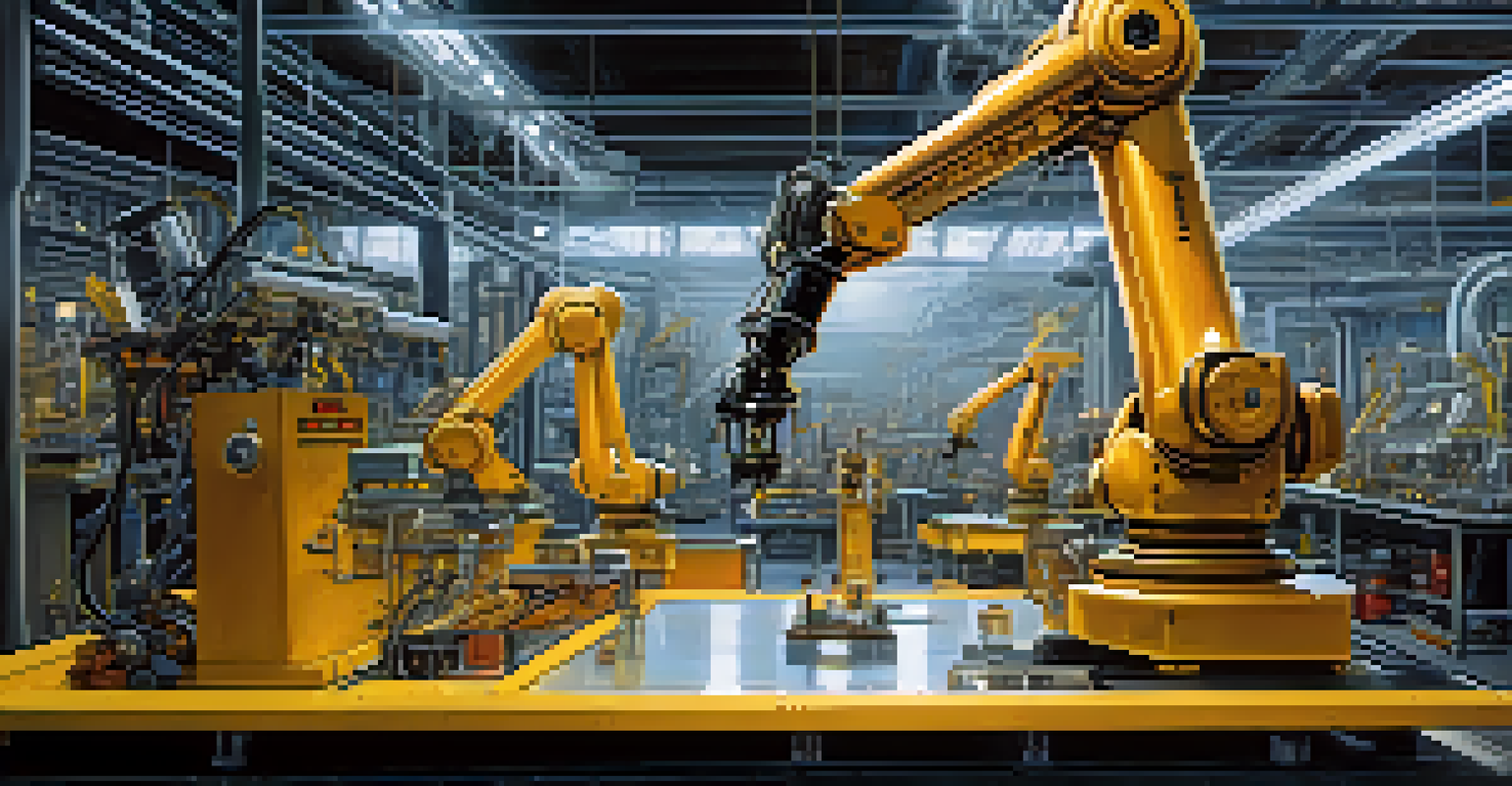Future Trends in Business Process Automation Technology

The Rise of Artificial Intelligence in Automation
Artificial intelligence (AI) is revolutionizing business process automation by enhancing decision-making capabilities. With AI algorithms, businesses can analyze vast amounts of data to identify patterns and optimize processes more efficiently than ever. For instance, AI-driven chatbots can handle customer inquiries, freeing up human employees for more complex tasks.
The greatest danger in times of turbulence is not the turbulence; it is to act with yesterday's logic.
Moreover, AI can learn from previous interactions, continually improving its responses and efficiency. This adaptive learning means that automation becomes smarter over time, leading to enhanced customer experiences and increased productivity. As companies adopt AI, they will likely see significant improvements in turnaround times and accuracy.
As we look to the future, AI's role in business process automation will only grow, making it essential for companies to invest in this technology. The potential for AI to transform workflows and reduce operational costs is immense, positioning it as a cornerstone of success in the automation landscape.
Robotic Process Automation (RPA) Expands Its Reach
Robotic Process Automation (RPA) is becoming a key player in streamlining repetitive tasks across various industries. This technology enables organizations to deploy software robots to handle mundane tasks, such as data entry or invoice processing, allowing human workers to focus on strategic initiatives. For example, a finance department can use RPA to automatically reconcile accounts, significantly reducing the time spent on manual processes.

As RPA technology matures, we can expect to see its integration with other automation solutions, creating more comprehensive systems. This synergy will allow organizations to automate complex workflows that involve multiple applications and data sources seamlessly. The result? Increased efficiency and reduced errors, ultimately enhancing service delivery.
AI Enhances Automation Efficiency
Artificial intelligence improves decision-making and customer experiences by analyzing data and adapting over time.
Looking ahead, RPA will likely evolve to incorporate more intelligent features, such as machine learning capabilities. This advancement will enable RPA systems to adapt to changes in processes and make decisions autonomously, further solidifying their role in business automation.
Integration with Cloud Technologies for Enhanced Flexibility
The shift towards cloud computing is a game-changer for business process automation, offering greater flexibility and scalability. Cloud-based automation solutions allow organizations to access their systems and data from anywhere, facilitating remote work and collaboration. This accessibility is crucial in today's fast-paced business environment, where adaptability is key to success.
Automation does not just replace jobs; it transforms them, creating new opportunities for innovative work.
Additionally, cloud technologies provide seamless integration with existing systems, enabling companies to leverage their current infrastructure while enhancing their automation capabilities. For instance, businesses can connect their ERP systems with cloud-based automation tools to streamline operations without requiring significant upfront investments.
As cloud technologies continue to evolve, we can expect even more robust automation solutions that cater to diverse business needs. This evolution will not only enhance operational efficiency but also foster innovation as companies experiment with new processes and technologies.
Embracing Low-Code and No-Code Development Platforms
Low-code and no-code development platforms are democratizing automation by allowing non-technical users to create and manage automated workflows. These platforms enable business users to build applications and processes without requiring extensive programming knowledge, making automation more accessible. Imagine a marketing team member creating a lead generation form without needing to consult IT.
This shift empowers organizations to respond more quickly to changing business needs, as teams can design and deploy solutions on their own. Consequently, companies can streamline operations and reduce the bottleneck often created by IT departments. As a result, innovation can flourish, leading to improved productivity across the board.
RPA Streamlines Repetitive Tasks
Robotic Process Automation reduces manual work by using software robots to handle mundane tasks, allowing employees to focus on strategic initiatives.
In the future, we can expect low-code and no-code platforms to become even more sophisticated, integrating advanced features like AI and machine learning. This integration will further enhance the capabilities of end users, allowing them to create intelligent automation solutions tailored to their unique business challenges.
The Importance of Data Security in Automation
As businesses increasingly rely on automation, ensuring data security becomes paramount. Automation can expose organizations to various risks, including data breaches and unauthorized access. Therefore, prioritizing security measures for automated systems is essential to protect sensitive information and maintain customer trust.
One effective approach is to implement robust encryption protocols and access controls within automated processes. This way, even if a breach occurs, the data remains secure and unreadable to unauthorized users. Regular audits and monitoring can also help identify vulnerabilities and strengthen overall security.
Looking forward, businesses must integrate security into their automation strategies from the outset. By doing so, they can mitigate risks and foster a culture of security awareness, ensuring that their automation efforts contribute to a safe and trustworthy environment.
Enhancing User Experience through Automation
User experience (UX) is becoming a focal point in business process automation, as companies strive to create seamless interactions for their customers. Automation can streamline processes, but if not implemented thoughtfully, it can also lead to frustration. For example, an automated customer service line that requires lengthy menu navigation can deter users rather than assist them.
To enhance UX, businesses must prioritize user-centered design principles in their automation strategies. This approach involves understanding user needs and expectations, allowing companies to create automated systems that are intuitive and user-friendly. Enhanced UX leads to higher customer satisfaction and loyalty, ultimately driving business success.
Security is Crucial in Automation
As automation increases, prioritizing data security through encryption and access controls is essential to protect sensitive information.
As automation technology advances, we can anticipate even more opportunities to personalize user experiences. By leveraging data and AI, businesses can tailor interactions based on individual preferences, making every engagement feel unique and valued.
The Future of Business Process Automation: A Holistic Approach
As we look toward the future, a holistic approach to business process automation will become increasingly important. Companies must recognize that automation is not just about technology; it's about integrating people, processes, and tools to drive meaningful change. By fostering a culture of collaboration and continuous improvement, organizations can maximize the benefits of automation.
This holistic perspective encourages businesses to assess their workflows and identify opportunities for improvement across all areas. It also promotes a mindset of agility, enabling organizations to adapt quickly to market changes and customer demands. In this environment, automation becomes a strategic enabler rather than just a tactical solution.

In summary, the future of business process automation lies in a comprehensive approach that considers the interconnectedness of technology, people, and processes. By embracing this mindset, organizations can unlock new levels of efficiency, innovation, and success.
The Role of Continuous Improvement in Automation Success
Continuous improvement is a crucial element for businesses seeking long-term success in automation. Implementing automation is just the beginning; organizations must consistently evaluate and refine their processes to ensure optimal performance. Regular assessments allow businesses to identify bottlenecks and areas for enhancement, keeping automation initiatives aligned with evolving business goals.
Additionally, fostering a culture of feedback and adaptability encourages employees to contribute insights and suggestions for improvement. Engaging team members in the process not only builds buy-in but also leads to innovative ideas that can enhance automation efforts. This collaborative approach creates a sense of ownership and accountability, driving sustained success.
Ultimately, the journey of business process automation is ongoing, requiring a commitment to continuous improvement. By prioritizing this mindset, organizations can stay ahead of the curve and fully realize the potential of their automation initiatives.